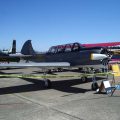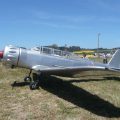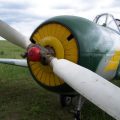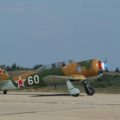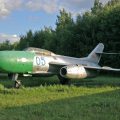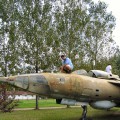
Jakovlevas Jak-50 | |
|---|---|
| Šalies | Sovietų Sąjunga |
| Tipas | Treniruoklis / akrobatinis orlaivis |
| Pagamintas | 1975-1986 |
| Pastatytas | 314 |
2007 Jakovlevas Jak-50 (Russian: Яковлев Як-50) aerobatic aircraft is a single-seat all-metal low-wing monoplane with retractable main wheels and exposed tail wheel. The control surfaces are fabric-covered to save weight. The aircraft is not equipped with flaps. The supercharged engine may be the Vedeneyev M14P (standard production line version), M14PF or M14R, producing between 360 and 450 hp and driving the propeller via a reduction gearbox. The landing gear, brakes and engine starter are operated by compressed air. Replenished by an engine-driven compressor, the main and emergency air bottles are contained within the forward fuselage between the firewall and fuel tanks.
Šaltinis: Jakovlevas Jak-50 Vikipedijoje
| Jakovlev Jak-50 vaikščioti aplink | |
|---|---|
| Fotografas | Vladimiras Yakubovas |
| Lokalizavimo | Haywardo oro uosto atviras namas |
| Nuotraukos | 64 |
Taip pat žiūrėkite:
2007 Jakovlevas Jak-50 is a single-seat aerobatic aircraft that was developed by the Soviet manufacturer Yakovlev in the 1970s. It is a low-wing monoplane with a metal fuselage and fabric-covered control surfaces. It has a retractable main landing gear and a fixed tail wheel. The Yak-50 is powered by a radial piston engine that drives a two-bladed propeller. The engine can be either the Vedeneyev M-14P, M-14PF or M-14R, producing between 360 and 450 horsepower.
"Jak-50" buvo sukurtas kaip sovietinės sukarintos aviacijos organizacijos DOSAAF instruktorius ir akrobatinis orlaivis. Pirmą kartą jis skrido 1975 m. birželio 25 d., o tarnybą pradėjo 1976 m. "Jak-50" pasirodė esąs sėkmingas akrobatinis orlaivis, laimėjęs du pasaulio čempionatus 1976 ir 1980 m. Jis taip pat buvo kelių šalių, įskaitant Lietuvą, Rusiją ir Ukrainą, karinis instruktorius.
2007 Yak-50 has excellent handling characteristics and a high power-to-weight ratio, allowing it to perform complex maneuvers and unlimited aerobatics. However, it also has some drawbacks, such as high fuel consumption, limited range and endurance, and structural fatigue due to the high stresses imposed on the airframe. Some Yak-50s suffered from wing spar failures, resulting in fatal accidents. The Yak-50 was eventually replaced by more advanced aerobatic aircraft, such as the Yak-55 and the Su-26.
Šiandien tik apie 90 "Jak-50" išlieka tinkami skraidyti ir priklauso privatiems pilotams ir kolekcionieriams įvairiose šalyse. "Jak-50" vis dar laikomas vienu geriausių savo eros akrobatinių orlaivių ir klasikiniu sovietinės aviacijos inžinerijos pavyzdžiu.
Peržiūrėta : 2018



